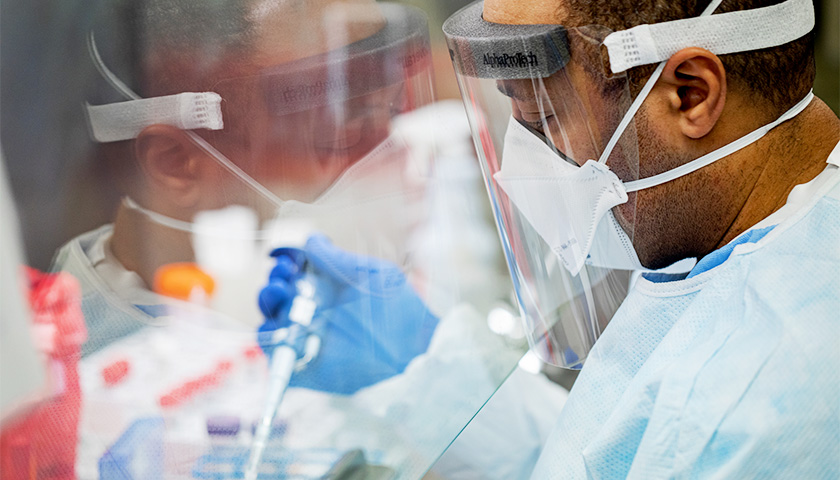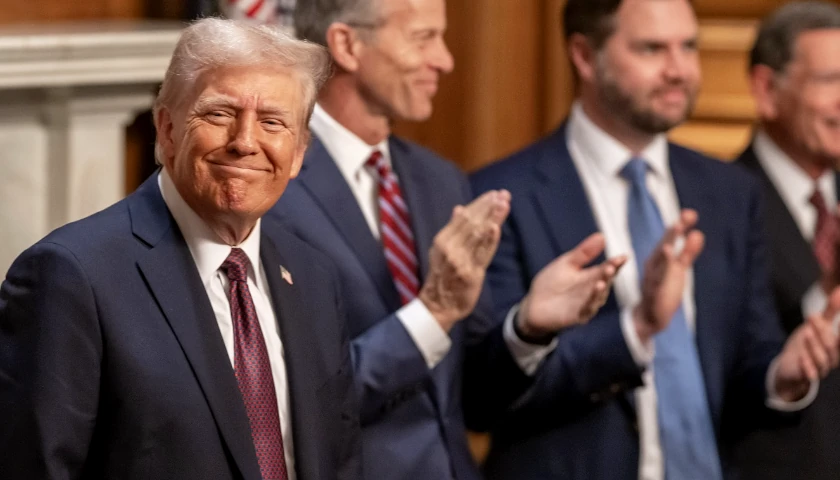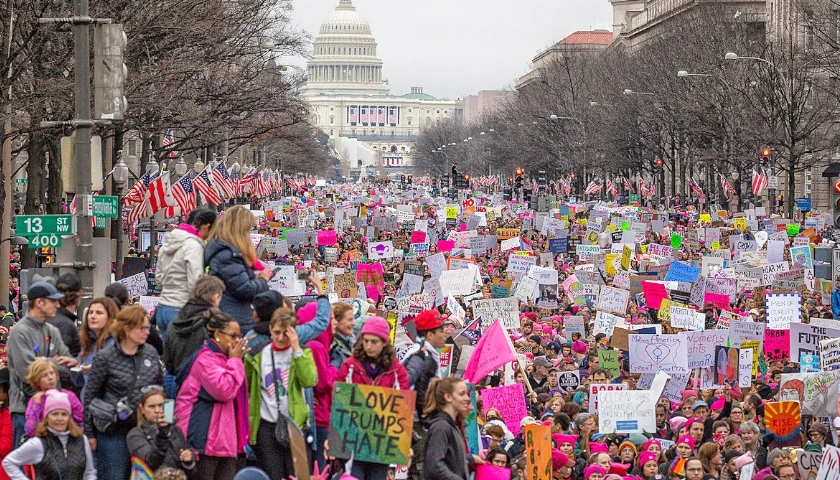by Debra Heine
Many scientists who have studied the Omicron virus believe that the fast-spreading COVID variant was mistakenly or perhaps purposefully released from a lab.
Investigative journalist Sharyl Attkisson spoke with several such scientists who told her that Omicron is unlikely to be a product of a natural evolution of SARS-Cov-2 in infected people because of the vast number of mutations that had to occur in order to create the new virus.
The origins of the Omicron outbreak are murky and suspicious: the virus was first detected in Botswana, South Africa, where it was reportedly brought in by a foreign delegation from an unidentified country. As Attkisson notes, public officials will not identify the country, making it more difficult for others to discover its origin.
“There was a large number of mutations in this variant—many more than we would expect from the normal evolution of this virus,” said virologist Andrew Pekosz, Professor of Molecular Microbiology and Immunology at the Johns Hopkins University Bloomberg School of Public Health. “Importantly, many mutations occurred in the spike protein—the protein the virus uses to bind to and enter cells—which is the target of the vaccine.”
A government researcher studying the virus who did not wish to be identified was the only scientist Attkisson spoke with who suggested Omicron occurred naturally.
“It did not follow the trajectory of the outbreak,” the researcher admitted. “One of the hypotheses is that there’s been a cryptic, a completely separate outbreak going on,” or a “cryptic transmission” independent of mice. “Perhaps someone immune-compromised was infected, and active replication of the virus was maintained for a very long time,” he said.
However, the alternate theory—that Omicron was concocted in a lab and escaped—is considered by many scientists to be the more likely scenario.
One scientist who has studied the matter told Attkisson that it is possible “that serial passaging in mice was done in a laboratory somewhere,” resulting in “an accidental or on purpose release on the back end.” He added: “The short version is that the least likely scenario is that this was a natural human transmission chain that created the lineage and we just failed to detect it. The number and makeup of the changes would have required a vast number of infections to support.”
A second scientist explained why another lab leak was not only possible, but probable.
“Every lab in the world is now working on COVID,” he told Attkisson. “It’s highly contagious and risky even with the best controls. The odds of an accidental release are pretty high.”
“It’s very hard to attribute where these things occur, but this is an unprecedented time we’re living in,” he said, “where there are a lot of lab facilities working on the virus at the same time. And so at any point, we have safety controls to try to keep the pathogens in the lab. But with so many people working under different conditions, different restrictions, different rules, the potential for lab release of some COVID related work is plausible. It’s something we need to consider.”
There are other features that reportedly set Omicron apart from a natural virus evolution.
These include “acquiring genetic features that didn’t exist or don’t have a precedent historically, suddenly appear in a very short timeframe” and “a change in the amount or the acquisition of change in a virus beyond what the expectation is,” another scientist told Attkisson.
Scientists have identified at least “45 point mutations that Omicron acquired since divergence from the B.1.1 lineage.”
The mutations represent what some consider to be an implausibly high number of changes for natural evolution that has resulted in Omicron’s greater transmissibility.
Another suspicious feature of Omicron, according to multiple scientists, is its apparent mouse origin.
The fact is, Chinese and American scientists who had partnered up on research for years prior to the pandemic, had found it exceedingly difficult to get the bat coronavirus they were studying to infect lab mice. So the researchers were, in essence, altering lab mice to give them human cells and attributes to get them to catch a genetically-manipulated version of Covid so that they could try to invent vaccines and treatments for it.
“The original virus had difficulties establishing infections in mice, and for laboratory use we had to have ACE2 transgenic mice [also known as] humanized mice that expressed the human ACE2 receptor,” says a scientist.
In other words, experts say rodents aren’t known to naturally catch and transmit Covid-19, so if Omicron came from a mouse host, it likely happened in an experimental lab.
According to mathematician and journalist Igor Chudov, that lab could have been in the United States—the University of North Carolina at Chapel Hill to be precise.
A paper trail leads to Ralph Baric, the Professor in the Department of Epidemiology, and Professor in the Department of Microbiology and Immunology at UNC, a pioneer in mouse-adapted SARS-COV-2 research.
Baric is no stranger to risky coronavirus gain-of-function research, and is thought by some to be a key player in the creation of the original COVID virus.
He is the scientist who:
• experimented with adding HIV genes to SARS-1 spikes
• found ways to mutate nsp-14 protein to make SARS-1 to spawn 21 times more variants. Sars-Cov-2 inherited a 5% mutated nsp-14 from SARS-1, and is now producting endless variants, oddly enough
• Found ways to enhance function of SARS-1 in 2007, to cause much more severe disease in mice, killing most older mice
• Created chimeric coronaviruses engineered to effectively infect humans
• Was given a “Moderna Vaccine Candidate” on Dec 12, before Sars-Cov-2 was officially known.
After successfully creating a mouse-adapted COVID virus that could infect both mouse cells, and human cells, Baric patented the research so that any such murine SARS-Cov-2 work would require UNC’s permission, Chudov noted.
• Baric’s article in Nature describes steps to genetically edit and develop a genome for such a mouse-infecting virus, derived from Wuhan Sars-Cov-2.
• Ralph Baric’s UNC owns US patent 11,225,508, which describes how he made a lab-made Covid-19 variant that infects mice and causes serious disease in mice (making Baric’s patented invention a bioweapon by definition).
• This patent by Baric makes UNC the only organization with a legal monopoly on his method of creating murine/human variants of Sars-Cov-2 due to patent protection
• Baric tested that his Mouse-Adapted (MA) virus is still capable of infecting human cells
• Baric also tested whether the new mouse-adapted variant could evade existing spike protein vaccines.
Attkisson notes that Chinese researchers have also concluded Omicron sprung from a lab, bolstering the case.
In a scientific paper entitled: “Evidence for a mouse origin of the SARS-CoV-2 Omicron variant,” authors Changshuo Wei, Ke-Jia Shan, Weiguang Wang, Shuya Zhang, and Qing Huan say the evidence indicates (progenitor of Omicron) jumped from humans to mice, where it somehow “rapidly accumulated mutations conductive to” [quick infection], “then jumped back into humans.”
“We found that the Omicron spike protein sequence was subjected to stronger positive selection than that of any reported SARS-CoV-2 variants known to evolve persistently in human hosts,” reports the analysis. “The number and frequency of mutations “was significantly different from the spectrum for viruses that evolved in human patients.”
“The molecular spectrum (i.e., the relative frequency of the twelve types of base substitutions) of mutations acquired by the progenitor of Omicron was significantly different from the spectrum for viruses that evolved in human patients, but was highly consistent with spectra associated with evolution in a mouse cellular environment.”
Attkisson asked a scientist at the U.S. Army Medical Research Institute of Infectious Diseases (USAMRIID) if he’d seen anything to suggest that an easily-accessible sample of Covid-19 was turned into a bioweapon.
Major Jeffrey Kugelman, the Division Chief of Molecular Biology replied, “There’s an ongoing discussion about Omicron and we don’t have enough evidence to say, but it did not follow the trajectory of the outbreak.”
“We’re still looking into why Omicron is so different, but it is quite different than we were expecting,” Kugelman said.
[rumble]https://rumble.com/embed/vvr3hn/?pub=lkvqh#?secret=h2wZFIPJmB[/rumble]
– – –
Debra Heine reports for American Greatness.
Photo “COVID-19 Inside a Lab” by Governor Tom Wolf. CC BY 2.0.





